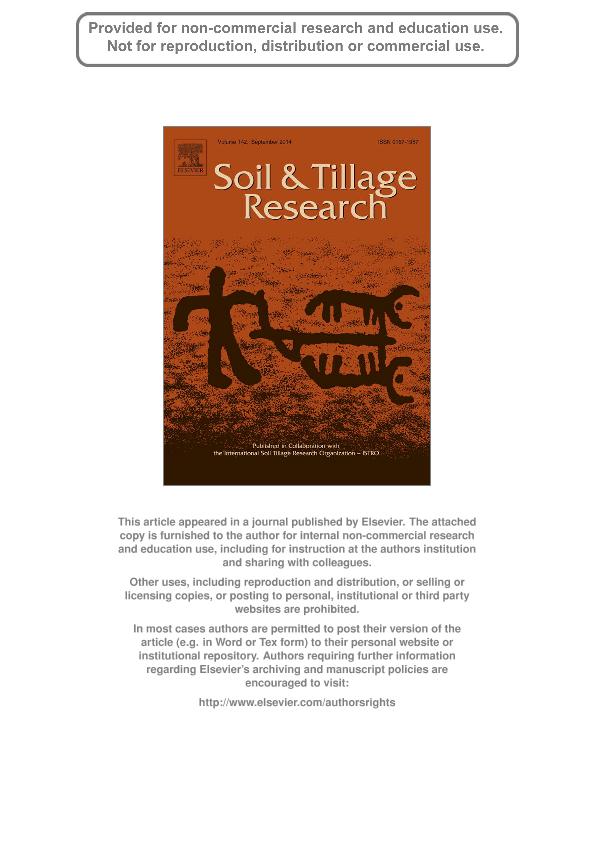Mostrar el registro sencillo del ítem
dc.contributor.author
Okada, Elena

dc.contributor.author
Costa, Jose Luis

dc.contributor.author
Bedmar, Francisco

dc.contributor.author
Barbagelata, Pedro
dc.contributor.author
Irizar, Alicia
dc.contributor.author
Rampoldi, Edgar Ariel

dc.date.available
2018-01-25T17:23:34Z
dc.date.issued
2014-05
dc.identifier.citation
Okada, Elena; Costa, Jose Luis; Bedmar, Francisco; Barbagelata, Pedro; Irizar, Alicia; et al.; Effect of conventional and no-till practices on solute transport in long term field trials; Elsevier Science; Soil & Tillage Research; 142; 5-2014; 8-14
dc.identifier.issn
0167-1987
dc.identifier.uri
http://hdl.handle.net/11336/34597
dc.description.abstract
The prediction and description of water and solute movement in soils under different tillage systems is essential to the study of pesticide contamination in soils and groundwater quality. However, the impact of tillage practices in soil physical characteristics varies across locations and types of soil. In this work we analyzed the long-term impact of no till (NT) and conventional tillage (CT) on solute transport within three different Argentinian soils. Bromide transport studies were conducted under controlled conditions in the laboratory using undisturbed soil columns. Samples were taken from long term field trials, with a history of over 16 years of NT and CT practices. The studied soils were: Paraná soil (PAR), a silty clay loam soil (<37% clay), and Mandfredi (MAN) and Pergamino (PER), both silty loam soils (<26% clay). Breakthrough curves were fitted using the non-equilibrium equation model (CDEneq). The following transport parameters were estimated from the fitted curves: velocity (v), hydrodynamic dispersion coefficient (D), dispersivity (λ), mobile water content (β), and mass transfer coefficient (ω). The relationship between the estimated parameters and soil properties was analyzed. Also, the parameters were compared between soils and tillage practices using a mixed linear model. Parameters v and D were positively correlated to soil clay content in NT samples. Such correlation was not observed in CT samples. This would suggest that clay content in soils under conservational tillage, favors the transport of solutes, as it increases v and D. In this study, no differences were found between soils or tillage practice regarding the estimated v parameter. Differences were found for D and λ between CT and NT samples in PAR soil. In this case, the magnitude of solute dispersion was higher in the NT samples. For the other soils (MAN and PER), no difference in D and λ between tillage practices was found. Effects of tillage on solute transport was not substantial in these soils, even when no till management had been applied for over 30 years. Whereas in PAR (the soil with higher clay content), soil management had an important effect on structure, and therefore on solute and water transport. These results suggest that in the PAR clayey soils studied, structure is well preserved under conservational tillage, and this could lead to an increase in the risk of leaching of solutes or chemical substances.
dc.format
application/pdf
dc.language.iso
eng
dc.publisher
Elsevier Science

dc.rights
info:eu-repo/semantics/openAccess
dc.rights.uri
https://creativecommons.org/licenses/by-nc-sa/2.5/ar/
dc.subject
Tillage
dc.subject
Solute Transport
dc.subject
Soil Culture
dc.subject.classification
Agricultura

dc.subject.classification
Agricultura, Silvicultura y Pesca

dc.subject.classification
CIENCIAS AGRÍCOLAS

dc.title
Effect of conventional and no-till practices on solute transport in long term field trials
dc.type
info:eu-repo/semantics/article
dc.type
info:ar-repo/semantics/artículo
dc.type
info:eu-repo/semantics/publishedVersion
dc.date.updated
2018-01-24T14:52:52Z
dc.journal.volume
142
dc.journal.pagination
8-14
dc.journal.pais
Países Bajos

dc.journal.ciudad
Amsterdam
dc.description.fil
Fil: Okada, Elena. Consejo Nacional de Investigaciones Científicas y Técnicas; Argentina. Instituto Nacional de Tecnología Agropecuaria. Centro Regional Buenos Aires Sur. Estación Experimental Agropecuaria Balcarce; Argentina
dc.description.fil
Fil: Costa, Jose Luis. Instituto Nacional de Tecnología Agropecuaria. Centro Regional Buenos Aires Sur. Estación Experimental Agropecuaria Balcarce; Argentina
dc.description.fil
Fil: Bedmar, Francisco. Consejo Nacional de Investigaciones Científicas y Técnicas; Argentina. Universidad Nacional de Mar del Plata. Facultad de Ciencias Agrarias; Argentina
dc.description.fil
Fil: Barbagelata, Pedro. Instituto Nacional de Tecnología Agropecuaria. Centro Regional Entre Ríos. Estación Experimental Agropecuaria Paraná; Argentina. Universidad Nacional de Entre Ríos. Facultad de Ciencias Agropecuarias; Argentina
dc.description.fil
Fil: Irizar, Alicia. Instituto Nacional de Tecnología Agropecuaria. Centro Regional Buenos Aires Norte. Estación Experimental Agropecuaria Pergamino; Argentina
dc.description.fil
Fil: Rampoldi, Edgar Ariel. Consejo Nacional de Investigaciones Científicas y Técnicas; Argentina. Instituto Nacional de Tecnología Agropecuaria; Argentina. Universidad Nacional de Córdoba; Argentina
dc.journal.title
Soil & Tillage Research

dc.relation.alternativeid
info:eu-repo/semantics/altIdentifier/doi/http://dx.doi.org/10.1016/j.still.2014.04.002
dc.relation.alternativeid
info:eu-repo/semantics/altIdentifier/url/https://www.sciencedirect.com/science/article/pii/S0167198714000609
Archivos asociados
